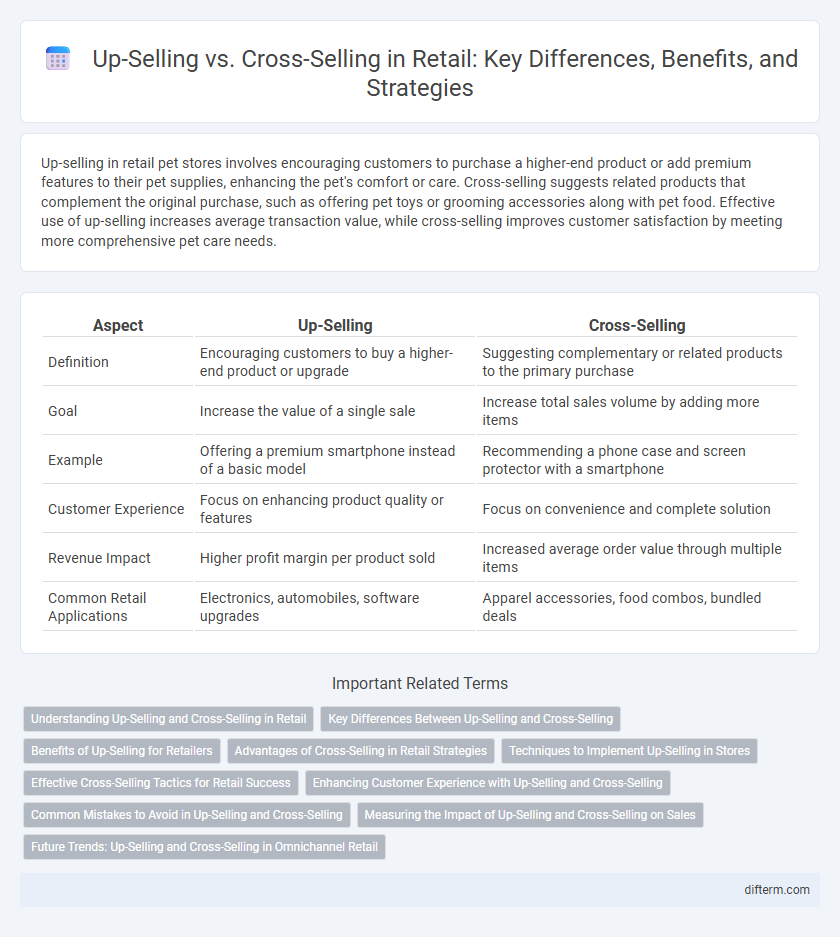Up-selling in retail pet stores involves encouraging customers to purchase a higher-end product or add premium features to their pet supplies, enhancing the pet's comfort or care. Cross-selling suggests related products that complement the original purchase, such as offering pet toys or grooming accessories along with pet food. Effective use of up-selling increases average transaction value, while cross-selling improves customer satisfaction by meeting more comprehensive pet care needs.
Table of Comparison
| Aspect | Up-Selling | Cross-Selling |
|---|---|---|
| Definition | Encouraging customers to buy a higher-end product or upgrade | Suggesting complementary or related products to the primary purchase |
| Goal | Increase the value of a single sale | Increase total sales volume by adding more items |
| Example | Offering a premium smartphone instead of a basic model | Recommending a phone case and screen protector with a smartphone |
| Customer Experience | Focus on enhancing product quality or features | Focus on convenience and complete solution |
| Revenue Impact | Higher profit margin per product sold | Increased average order value through multiple items |
| Common Retail Applications | Electronics, automobiles, software upgrades | Apparel accessories, food combos, bundled deals |
Understanding Up-Selling and Cross-Selling in Retail
Up-selling in retail involves encouraging customers to purchase a higher-end product or an upgraded version of the item they initially considered, enhancing their overall value and experience. Cross-selling focuses on recommending complementary or related products that enhance the primary purchase, increasing the total transaction value. Both strategies leverage customer data and purchase history to personalize offers and drive revenue growth effectively.
Key Differences Between Up-Selling and Cross-Selling
Up-selling involves encouraging customers to purchase a higher-end version of a product they are considering, increasing the overall sale value by enhancing product features or quality. Cross-selling focuses on suggesting complementary or related products to the original purchase, aiming to broaden the customer's basket and improve total transaction size. The key difference is that up-selling elevates the existing product choice, while cross-selling expands the product mix by adding new items.
Benefits of Up-Selling for Retailers
Up-selling increases average transaction value by encouraging customers to purchase higher-end or premium products, directly boosting retailer revenue. It enhances customer satisfaction when executed correctly, as consumers often perceive upgraded options as better quality or value. This strategy also helps retailers maximize inventory profitability and improve customer lifetime value through tailored recommendations.
Advantages of Cross-Selling in Retail Strategies
Cross-selling in retail strategies enhances customer lifetime value by promoting complementary products, increasing average transaction size without significant acquisition costs. This approach leverages existing customer trust to introduce related items, improving overall shopping experience and satisfaction. Retailers benefit from higher inventory turnover and optimized shelf space utilization, driving incremental revenue growth efficiently.
Techniques to Implement Up-Selling in Stores
Implementing up-selling techniques in retail stores involves training staff to recognize customer needs and suggest higher-value alternatives that enhance the shopping experience. Utilizing point-of-sale prompts and personalized recommendations based on purchase history can increase average transaction value. Displaying premium products prominently and offering bundled upgrades encourage customers to choose more expensive options without feeling pressured.
Effective Cross-Selling Tactics for Retail Success
Effective cross-selling tactics in retail involve personalized product recommendations based on customer purchase history and preferences, increasing average transaction value by suggesting complementary items. Implementing data-driven insights and utilizing point-of-sale prompts or online algorithms enhances customer engagement and encourages additional purchases. Training staff to identify natural opportunities for cross-selling fosters a seamless shopping experience and boosts overall revenue.
Enhancing Customer Experience with Up-Selling and Cross-Selling
Up-selling in retail encourages customers to purchase higher-end products or add premium features, enhancing satisfaction by meeting their evolving needs. Cross-selling introduces complementary products that increase convenience and value, deepening the shopping experience. Together, these strategies boost revenue while fostering personalized customer engagement and loyalty.
Common Mistakes to Avoid in Up-Selling and Cross-Selling
Neglecting customer needs can hinder the effectiveness of up-selling and cross-selling strategies, causing lost sales and customer dissatisfaction. Overloading customers with irrelevant or excessive product recommendations often results in decision fatigue and reduced conversion rates. Failing to train sales staff properly leads to missed opportunities and inconsistent messaging, undermining trust and limiting revenue growth in retail environments.
Measuring the Impact of Up-Selling and Cross-Selling on Sales
Measuring the impact of up-selling and cross-selling on sales involves analyzing key performance indicators such as average transaction value, conversion rates, and customer lifetime value. Advanced analytics tools track changes in purchase behavior and revenue growth attributed to these strategies, enabling retailers to quantify effectiveness. Comparing these metrics before and after implementation helps optimize sales techniques for maximum profitability.
Future Trends: Up-Selling and Cross-Selling in Omnichannel Retail
Future trends in up-selling and cross-selling within omnichannel retail emphasize seamless integration of AI-driven personalized recommendations across online and offline touchpoints. Retailers leverage data analytics and machine learning to predict customer needs, enabling dynamic product bundling and tailored offers in real time. Enhanced AR/VR technologies and mobile platforms further facilitate interactive shopping experiences that boost conversion rates and customer loyalty.
Up-Selling vs Cross-Selling Infographic

 difterm.com
difterm.com